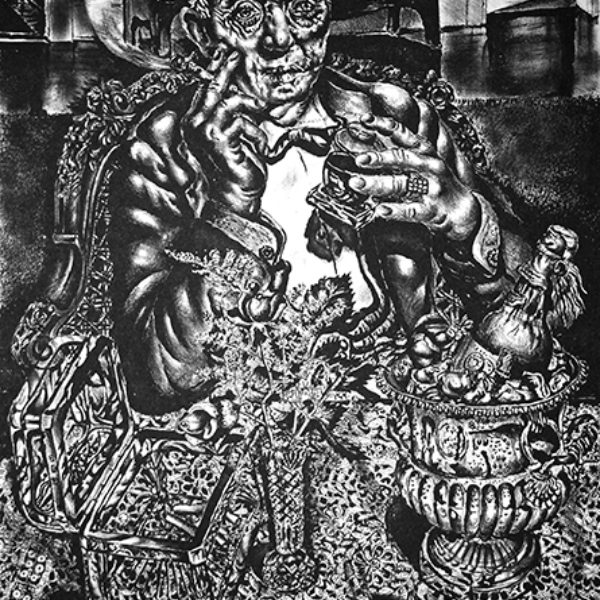
Ivan Albright
b. 1897, North Harvey, IL - d. 1983, Woodstock, VT
Ivan Le Lorraine Albright and his twin Malvin were born to the very popular and successful Chicago impressionist painter, Adam Emory Albright, on February 20, 1897, in North Harvey, Illinois, just south of Chicago. Along with their older brother Lisle, the twins were exposed to art from an early age and were frequent models for their father’s sunny scenes, which often featured sweet children in the outdoors. In 1910, the elder Albright moved his family to a large log house of his own design in the northern suburb of Hubbard Woods (now part of Winnetka), where he had a studio and entertained groups of admirers and patrons. Ivan consistently resisted following his father’s professional path, beginning his education as a student at Northwestern University in 1915 and, after failing out, studying architecture and engineering at the University of Illinois the following year. When the United States entered World War I in 1918, he enlisted and was assigned to a military hospital in Nantes, France where he was a “medical drawer” recording wounds and surgical procedures.
After being discharged from the military, Albright worked briefly in an architectural firm and in commercial advertising, still contending that he was not interested in becoming a painter. By 1920, however, having decided that both architecture and advertising were too commercial for him, Albright enrolled with his brother at the School of the Art Institute of Chicago (SAIC), graduating in 1923. Between 1923 and 1924, Albright studied for one term each at the Pennsylvania Academy of the Fine Arts in Philadelphia and the National Academy of Design in New York. In 1926, the brothers returned to Warrenville, Illinois, where Adam Emory had settled the family in a remodeled former Methodist Church in 1924. There, Ivan, Malvin, and their father carved out individual studio spaces; several years later the twins built separate studios in which they continued to work while in the Chicago area. In the same year, Ivan won an Honorable Mention in the Art Institute’s American Annual Exhibition; despite having completed several ambitious paintings and participated in a number of exhibitions, this recognition validated him as an artist and marked the beginning of his professional career. Understandably, Ivan was extremely competitive, and was a regular participant and prize winner in juried exhibitions as well as gallery shows all of his life. He had the luxury of not needing to sell his work, and priced it so high that it was often beyond the means of even wealthy patrons. Albright saw his true peers as the Old Masters—particularly the artists of the Northern Renaissance—but also learned from his European and American contemporaries and, although he would deny it consistently, his family.
He developed a highly personal style in which he sought to incorporate the seemingly irreconcilable—time and space, the finite and the infinite, the material and the spiritual—into a harmonious whole. His major subject was the transience of matter, which can be traced to the late medieval Vanitas theme, and is clearly expressed in the Self-Portrait at 55 East Division Street, a lithograph of 1947, in which Albright, whose face is a mass of wrinkles suggesting extreme deterioration is seated behind an elaborate still life rendered in hyperrealistic detail. Using an obsessive technique harking back to Old Masters he revered, his work reflects his traditional academic education and an esteem for careful representation of visual reality as he perceived it. Always working from a model, he often spent years creating a single painting, adding detail upon detail until he was satisfied with the comprehensive quality of his image.
Albright participated briefly in the government sponsored art projects of the Great Depression, completing two paintings for the PublicWorks of Art Project and working briefly on the Illinois Art Project in 1936. He submitted work to and often won awards at national exhibitions such as the Pennsylvania Academy of Fine Arts Annual, Carnegie Internationals in Pittsburgh, Corcoran Biennials in Washington, DC, and Whitney Annuals in New York City. He achieved widespread public notice in 1943 when the MGM film studio commissioned him to paint an allegorical portrait for the feature film, The Picture of Dorian Gray, based on the Oscar Wilde novel of the same name. His mature style, in which the disintegration of the flesh was perfected, was the perfect vehicle for expressing both the quality of aging and debauchery necessary to his subject.
In 1946, Ivan Albright married socialite and newspaper heiress Josephine Patterson Reeve (1913–1996). After living in and around Chicago for sixty-six years, Albright moved with his family to the quiet of Woodstock, Vermont, in 1963. The following year, a retrospective exhibition was organized by the Art Institute of Chicago and traveled to the Whitney Museum of American Art in 1965. During the 1970s, Albright was a visiting artist and lecturer at Dartmouth College in Hanover, New Hampshire. He remained active as an artist until his death in 1983.
References
Donnell, Courtney, Susan Weininger, and Robert Cozzolino. Ivan Albright. Chicago: Art Institute of Chicago, 1997.
Warren, Lynne, ed. Art in Chicago, 1945–1995. Chicago: Thames and Hudson and Museum of Contemporary Art Chicago, 1996.
Weininger, Susan. “Ivan Albright.” In Elizabeth Kennedy, ed. Chicago Modern, 1893–1945: Pursuit of the New, 82. Chicago: Terra Foundation for the Arts, 2004.
Artist Image: Ivan Albright in his Ogden Avenue studio, Chicago, 1950. Photograph by Peter Pollack.
